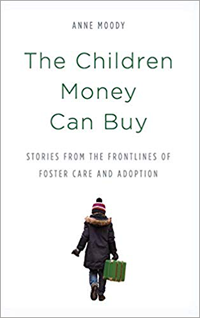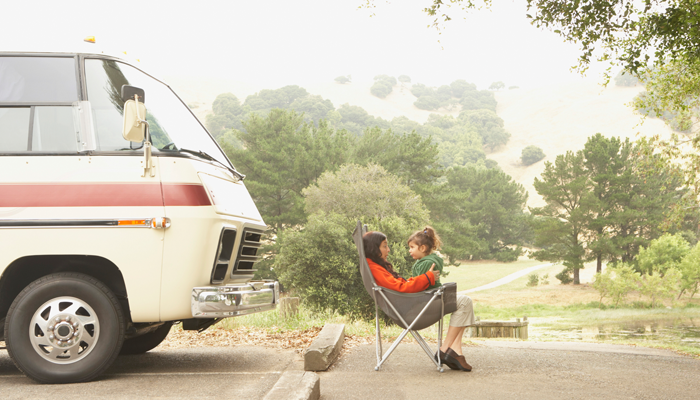Many adoptive parents find the idea of talking to their children about adoption awkward, even stressful. Some fear making a crucial mistake that will hurt or frighten their child, and possibly damage their relationship. But the #1 key, in fact, is to avoid treating the topic like a big, scary discussion or sit your child down for “The Talk.” Instead, keep your conversations about adoption open, relaxed, and in-the-moment.
It’s a good idea to begin talking about adoption when your child is still a baby, or as soon as your child joins your family. Children may not reciprocate or show much interest in the subject until they have some idea about “where babies come from” or, in the case of transracial adoption, until they begin to notice that they look different from the other people in their family. Some particularly sensitive and/or astute children begin asking questions almost as soon as they have the words to do so, but the norm is usually between ages three and six.
I don’t have a script to guide parents through these talks—there is no one-size-fits-all template—but I do have some suggestions based on my many years of working with adoptive families and my own experience as an adoptive parent. Just remember, the most important thing you can do is to create an environment in which adoption is talked about in a casual and informative manner, like any other subject that is of interest to your family.
2. Document the process.
Keep a journal during your adoption process. It does not have to be elaborate or eloquent; the facts will speak for themselves. When we were waiting for Jocelyn (my youngest child, who was adopted from South Korea), I started a journal that was written as if I were talking to her. It included such routine information as “We sent in the immigration forms today,” and “I made new curtains for your room.” It also included more emotional entries, such as “I stood over your crib for a long time today and imagined what it will be like when you are here.” I am not usually a journal keeper, but I wanted Jocelyn to see that adoption wasn’t simply a matter of the parents’ putting their names on a list and then—voila!—a child appears. I wanted her to know how complicated and careful the process was, and how everyone involved was focused on taking good care of the children.
When Jocelyn was a toddler, we would look at the journal and admire things like the pictures her sisters had drawn, imagining what she’d look like, and the cute invitation to her baby shower. At about six years old—a non-mushy stage for her—we decided to read the book as a bedtime story. I read every word of the text, and she paid attention to every detail. She heard about the preparation of her room, about all the interest from friends and family, about her sisters’ plans for her. She heard me say over and over again that I was so excited, that we were all so excited, that we could hardly stand the wait. She heard me get really mad when immigration lost our forms, and she heard me describe what it was like to see her picture for the first time. As I read to her, I realized that that little book, in all its mundane detail, was telling her how much we loved her. Normally, as a squirmy six-year-old, she wouldn’t have allowed the expression of such sentiment, but she was all ears night after night. I had anticipated that the journal would be helpful in explaining the adoption process, but it was far more important than that: It was written-down, irrefutable proof of our love.
3. Create visual reminders/celebrations of the adoption.
Babies love to look at pictures of themselves, and I think the simplest and best way to introduce adoption to a child is with pictures. These could be pictures of the first time you held your child in the hospital or on your adoption trip, referral pictures from the agency, pictures of your family in the courtroom when the adoption was finalized, or pictures from a party celebrating that event. The important point is to have them available to your child and to display them where they can be appreciated. It will then be easy to make casual comments like, “That was the day we finalized your adoption. We were so happy.” That way your child gets familiar with the word “adoption” before having any idea what it means, and also gets the message that the word is associated with happiness.
4. Seize the moment with books and movies.
There are many good books that pave the way for discussions about adoption with young children, but you have to be careful about your selections because there are lots of clueless books as well. My least favorite are those that reassure children that they’re not flawed even though they were adopted. It is amazing how many children’s books have this slant.
The subject of adoption can also be brought up when your child sees a movie or television show that deals with adoption—whether directly or in which the main character is a lonely child or animal in need of a family. Unfortunately, there is an abundance of inaccurate and negative portrayals of adoption, so parents have to be careful—although, even these can offer a chance for discussion and education. Often, it is helpful simply to say something like, “Wow, they sure got that wrong,” when you see an incorrect portrayal.
5. Prepare your child for questions from peers.
The world is intensely curious about adoption. You’ve probably been asked many questions, and, before you know it, your child will be, as well. It’s helpful to always keep in mind that your child’s story is hers and that she alone should decide how and when to share it with others. Parents can encourage their children to be open and relaxed about the subject of adoption in general while still preserving the privacy of their personal stories.
A friend of mine who is also an adoption counselor told me about her experience with her daughter, who was adopted as an infant. When she was playing outside with a group of children one afternoon, an older child announced that Julia was adopted—something that was not a secret. But then another child asked, “Why didn’t your real mom want you?” Unfortunately, although Julia understood some things about adoption, she had no idea how to respond to this new idea that she had been unwanted or that her real mom was someone other than her mom. She came home crying, and her mother felt terrible for not having foreseen this situation, even though she regularly counseled other families about talking with their kids about adoption.
When adoptive parents talk about experiences like this, they usually focus on how insensitive other people can be about adoption. But we don’t actually know that any of the children in this situation meant to be unkind. They are likely to bring it up again, however—not necessarily because they are mean but because Julia’s reaction let them know how emotionally charged the subject is for her and they will want to figure out what the “deal” is with adoption. If Julia had responded by saying, “My birth mom was too young to take care of a baby,” this matter-of-fact reply might have shown the other children that Julia did not think of adoption as an upsetting subject.
Clearly, it is asking a lot of a seven-year-old to educate the world about adoption and deflect possible bullying with one carefully chosen sentence. It is not, however, too much to ask of adoptive parents that they have conversations with their children that will help prepare them for people’s natural curiosity about adoption. Even if Julia had been well prepared for this encounter, things might have turned out badly; but, as it was, she simply had no tools to help her handle the situation.
6. Silence is not golden.
Many adoptive parents tell me they feel that their child has no interest in adoption because he never asks any questions. When the parents brought it up, the child seemed disinterested, so they now assume that if he wants to know more he will say so. I hear some version of this from all sorts of parents, including absolutely wonderful parents who would be happy to talk with their child if they thought he wanted to talk. I also hear it from parents who aren’t comfortable talking about adoption, are clearly transmitting their discomfort to the child, and are relieved by the child’s silence. But I do not believe that most of the silent children are simply not interested; I believe that they have gotten the message that something about adoption makes people uncomfortable and they are nervous about finding out why this is true.
7. Honesty or protection?
Part of an adoption counselor’s responsibility to the child being adopted is to elicit a promise from the adoptive parents that they will disclose the fact of adoption to the child and will give him or her accurate information about the birth parents and the circumstances of the adoption. Accepted policy is that all available information should be shared with the person who has been adopted at an age-appropriate time.
I had always assumed I was a proponent of full disclosure until the day I received a referral for one of my families. Typically, referrals indicate that the birth parents had not been in a good situation to raise a child and consequently had chosen adoption. But this referral said, “The young birth mother died in childbirth while screaming in agony.” It was painful to read and hard to imagine any possible benefit from having this image embedded in the child’s mind as she grew. When young, it would be enough for the child to know that her birth mother had died.
I also came to realize that I didn’t completely trust the information in referrals; the people who wrote them could make mistakes and misinterpretations just like anyone else. For example, referrals sometimes contained judgmental descriptions, such as “bar girl.” Why was it important to describe a birth mother as a “bar girl,” as if this were the absolute and overriding truth of her life, rather than as a loving daughter, great cook, good storyteller, wonderful sister, beautiful singer, or any of the other qualities she might have had that would be far more important in helping a child understand what she was actually like?
Another area in which openness and honesty can get complicated for adoptive parents is when the child has memories of an abusive birth parent. In these cases, honesty is still best, but it’s important that parents not condemn the birth parents as evil. One mother I worked with told her child how glad she was that he was now safe from the abusive behavior, which had clearly been wrong, but would also find positive things to say, such as by pointing out that he had inherited his birth father’s beautiful eyes and strong legs.
8. All things in moderation.
Keeping the lines of communication about adoption open does not mean bringing up the subject at every opportunity. It means that you handle the subject comfortably when it comes up, letting your child know that adoption is important and interesting to you but that you are not fixated on it. Most children don’t like it when their parents make too big a deal about something, and they especially don’t like being singled out or made to feel different. Artificially initiated conversations about adoption can trigger feelings of discomfort, and parents may mistakenly conclude that the adoption rather than the parent’s approach is the problem. It is important to respect children’s privacy and give them room to develop their own feelings about adoption and their birth parents. Parents need to understand that these issues can be quite separate from their own relationship with their child.
**
 Author’s note: Hopefully most prospective readers are intrigued by the title The Children Money Can Buy, but I have heard from some who are shocked, angry, and offended at what they assume is the suggestion that an exchange of money somehow taints adoptive families. As an adoptive parent and counselor, I certainly don’t promote the idea that our children have been purchased. The title was actually chosen to draw attention to the unethical practices our society tolerates in both the foster care and adoption systems, practices that I believe should indeed shock, anger, and offend people. I want readers to confront the hard realities of the underfunded and underserved children in foster care. I want to open reader’s eyes to the fact that there really are “baby brokers” controlling a significant segment of infant adoptions in the U.S. today. I want people to question the painful realities of the financial discrepancy between birth and adoptive parents in both domestic and international adoption. As adoptive parents, I believe we have a responsibility to recognize that these problems exist and that they impact the well-being not only our own families but of society as a whole. But what I specifically mean by “the children money can buy” are the children who come from happy and secure homes in which their needs are being met and they have been given every opportunity to thrive. For a full explanation, see Chapter 31.
Author’s note: Hopefully most prospective readers are intrigued by the title The Children Money Can Buy, but I have heard from some who are shocked, angry, and offended at what they assume is the suggestion that an exchange of money somehow taints adoptive families. As an adoptive parent and counselor, I certainly don’t promote the idea that our children have been purchased. The title was actually chosen to draw attention to the unethical practices our society tolerates in both the foster care and adoption systems, practices that I believe should indeed shock, anger, and offend people. I want readers to confront the hard realities of the underfunded and underserved children in foster care. I want to open reader’s eyes to the fact that there really are “baby brokers” controlling a significant segment of infant adoptions in the U.S. today. I want people to question the painful realities of the financial discrepancy between birth and adoptive parents in both domestic and international adoption. As adoptive parents, I believe we have a responsibility to recognize that these problems exist and that they impact the well-being not only our own families but of society as a whole. But what I specifically mean by “the children money can buy” are the children who come from happy and secure homes in which their needs are being met and they have been given every opportunity to thrive. For a full explanation, see Chapter 31.
ANNE MOODY has enjoyed a long career in child welfare work and adoption counseling. She is the director of an adoption agency in Bainbridge Island, Washington and the author of The Children Money Can Buy: Stories from the Frontlines of Foster Care and Adoption. She is a mother through birth and adoption.
This article was adapted with permission from The Children Money Can Buy: Stories from the Frontlines of Foster Care and Adoption, by Anne Moody (Rowman & Littlefield). All rights reserved.

